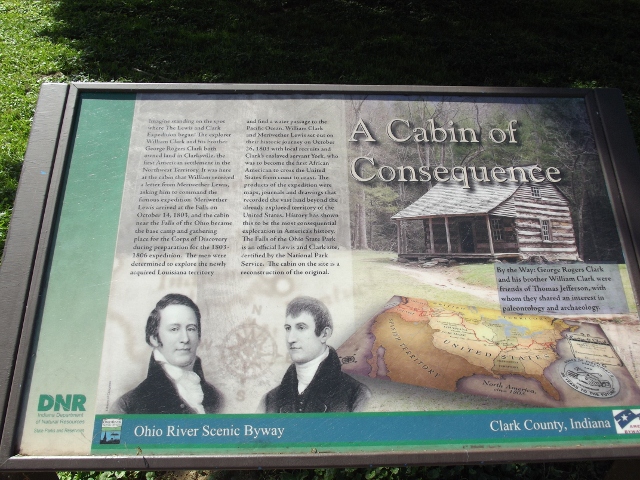.jpg) |
| George Rogers Clark Homesite - Clarksville, Indiana |
 | ||
| A Visit to the Falls of the Ohio State Park |
General George Rogers Clark
Revolutionary War Hero General George Rogers Clark settled on this beautiful spot overlooking the grand Ohio River. General Clark's fame came from his exploits during the winter of 1778 during which he captured the three British posts in the Illinois country, Vincennes, Cahokia and Kaskaskia. This courageous expedition, composed of 175 men, took these posts without firing a shot, thus securing what would become the Northwest Territory from the British. Congress carved six states from this immense territory; Indiana, Illinois, Michigan, Wisconsin, Minnesota and Ohio. General Clark borrowed the money to fund the expedition. The United States Government never properly compensated him for his exploits and he spent most of his last days dealing with financial difficulties.
Land Grant
For his services the State of Virginia awarded General Clark 150,000 acres, called the Clark Grant. This grant makes up most of current Clark County. Clark built a cabin and a grist mill on the spot occupied by the replica and lived there until 1809, when he had a stroke and fell into the fireplace, burning his leg. The leg needed amputation so he could no longer operate the mill. He moved to live with his brother-in-law in Kentucky, dying in 1818 after suffering another stroke.
 |
| General George Rogers Clark Cabin and His Servants the McGee’s |
General George Rogers Clark Cabin and His Servants the McGee’s
The cabin on this spot is not the original cabin. There are no known drawings of that cabin, destroyed in 1854. This one comes from Ripley County, Indiana near the town of Osgood. The State of Indiana moved it here in 2001,
The smaller cabin is also a replica of the cabin occupied by Clark's servants, the McGee’s. Technically slavery was illegal in the Northwest Territory so many slaves that lived there became free when the Northwest Ordinance became law. Many, lacking money to buy land, signed indentured servants agreements with their former masters. Their masters granted freedom and a tract of land to them as payment after a set period of servitude.
 |
| George Rogers Clark Homeside Interpretive Panels |
Interpretive Panels Describe the Gathering of the Corps of Discovery
William Clark, General Clark's younger brother, occupied the cabin with his brother. He kept up correspondence with President Thomas Jefferson, with whom both he and his brother George were friends. In 1803, he received a letter from the President requesting him to form up a company to explore the vast new acquisition, the Louisiana Territory that Jefferson had purchased from France in 1803. The cabin thus became a staging point for the Corps of Discovery. The expedition, now known as the Lewis and Clark Expedition, launched on the nearby river.
The Department of Natural Resources has erected several interpretative plaques outlining the beginnings of this voyage and the men that took part in it.
Overlooking the Majestic Ohio River
Visitors, during the time the park is open, can browse through the cabins and meander through the grounds. There are picnic tables allowing the visitor to gaze out over the waters of the Ohio River as they enjoy their lunch.
Beginning the Lewis and Clark Expedition
The area is ripe with history as the final home of an American Revolutionary War hero, sometimes called the "Conqueror of the Northwest" General George Rogers Clark and his famous brother William Clark, one of the leaders of the Lewis and Clark Expedition.
1102 W. Harrison Ave.
Clarksville, IN.
Comments
Post a Comment